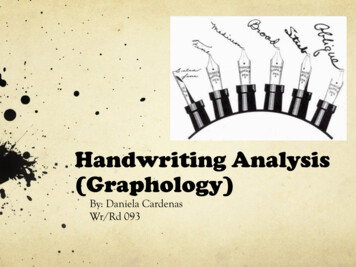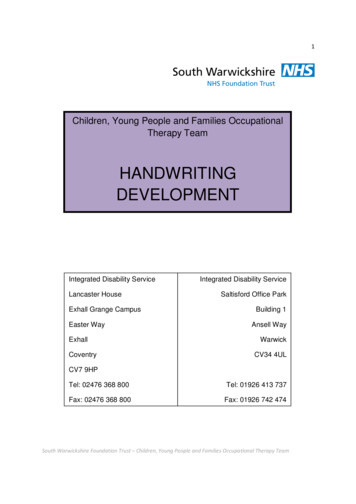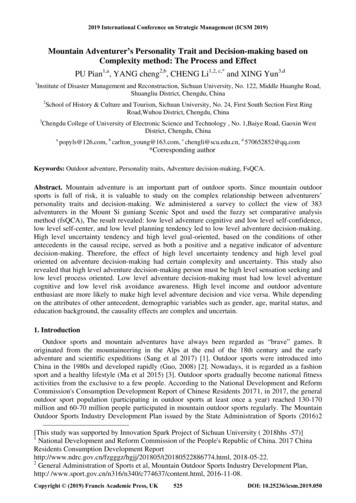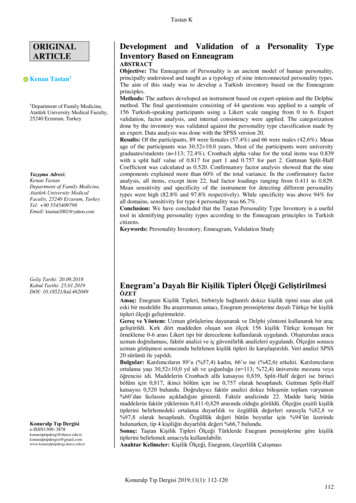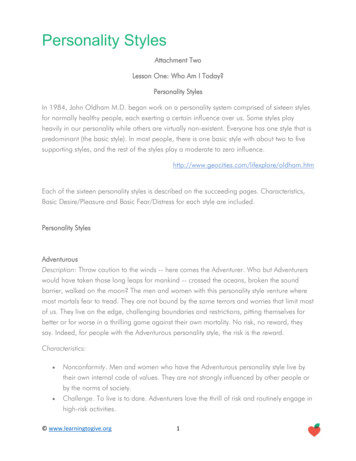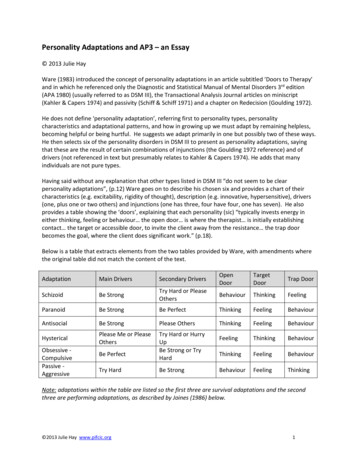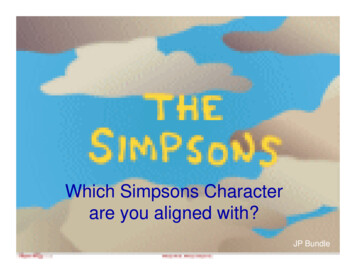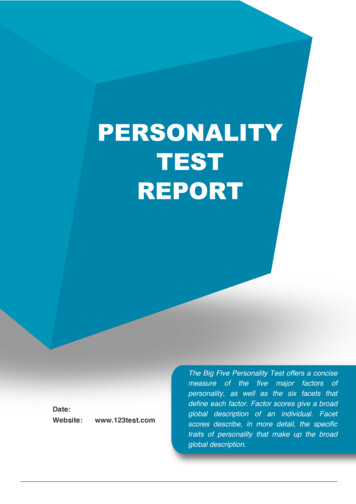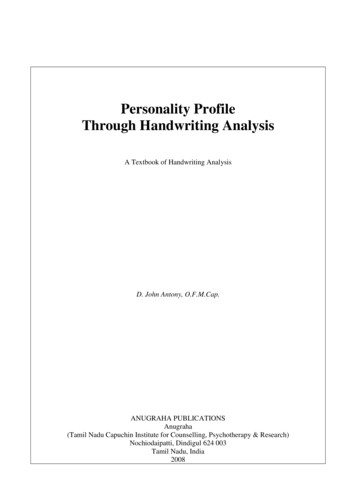
Transcription
Personality ProfileThrough Handwriting AnalysisA Textbook of Handwriting AnalysisD. John Antony, O.F.M.Cap.ANUGRAHA PUBLICATIONSAnugraha(Tamil Nadu Capuchin Institute for Counselling, Psychotherapy & Research)Nochiodaipatti, Dindigul 624 003Tamil Nadu, India2008
2Graphology - 12D. John Antony, O.F.M.Cap., 2008Other Books by the Author:01. Dynamics of Counselling02. Skills of Counselling – 2nd Edition03. Types of Counselling04. Psychotherapies in Counselling05. Self Psychology in Counselling06. Family Counselling07. Trauma Counselling08. Emotions in Counselling09. Mental Disorders Encountered in Counselling10. Tamil11. TamilFirst Edition: September 2008Published by: Anugraha Publications: Anugraha (Tamil Nadu Capuchin Institute forCounselling, Psychotherapy and Research)Nochiodaipatti PostDindigul – 624 003Tamil Nadu, IndiaTel: 0451 – 2550100, 2550324, 255083Email: anugrahacap@eth.netPrinted at:
3Graphology - 12Personality ProfileThrough Handwriting AnalysisTABLE OF CONTENTSTable of Contents (General) .Table of Contents (Detailed) .030401. General Instructions & Exercises.1102. Introduction.1203. Human Dimensions.2004. Baseline.2405. Slant .3006. Size.4107. Margin .4708. Pressure.5709. Speed .6010. Spacing.6311. Zones .6712. Printing and Cursive Writing .7513. Connecting Strokes .7914. Signatures.8415. Introversion and Extroversion.9216. Employment Aptitude.9517. Intelligence.9618. Honesty.9919. Graphotherapy.10520. Checklist for Analysing.10721. Bibliography.11122. Endnotes.113.
4Graphology - 12Personality ProfileThrough Handwriting AnalysisTABLE OF CONTENTS01. GENERAL INSTRUCTIONS & EXERCISES01. General Instructions02. Exercises03. INTRODUCTION01. Graphology02. Brain writing03. Expressive Behaviour04. Projective Test05. Conscious and Unconscious06. Fixed and Unfixed Traits07. Graphic Structures07.1. Baseline07.2. Enclosure07.3. Imposed Structure07.4. Stroke08. Graphometry09. Mimic and Symbolic Schools09.1. Mimic School09.2. Symbolic School10. Interpretation11. Inferences11.1. Physiological Inference11.2. Commonsense Inferences11.3. Universal Concepts Inferences11.4. Psychological Inferences11.5. Scientific Inferences04. HUMAN DIMENSIONSO1. Physical01.1. Identity01.2. State of Physical Health02. Mental03. Emotional
505. BASELINE01. Stable Baseline (Straight Baseline)02. Cautious Baseline (Overly Straight Baseline)03. Healthy Baseline (True Ascending Baseline)04. The Quitter Baseline (False Ascending Baseline)05. The Classical Quitter Baseline (Convex Baseline)06. Hysterical Baseline (Partial Ascending Baseline)07. Depressive Baseline (Descending Baseline)08. Crashing Baseline (Suicidal Baseline)09. Sudden Sinking Baseline (Partial Descending Baseline)10. Finally Making Up Baseline (Concave Baseline)11. Moody Baseline (Erratic Baseline)12. Sociopathic Baseline (Incoherent Baseline)06. SLANT01. Vertical Slant02. Rightward Slant03. Leftward Slant04. Finding out Slants05. Slant Reveals Emotions06. Interpretations06.1. Vertical Slant06.2. Rightward Slant06.3. Leftward Slant06.4. Unstable Slant07. Parameter of Slants08. Definitions of Slants09. Slant Chart10. Changes in Slant of Certain Letters, Words, and Phrases11. Maniac d06. SIZE01. Large Writing02. Overly Large Writing03. Medium-Sized Writing04. Small Writing05. Overly Small (Microscopic) Writing06. Word Enlargement or Diminution07. A letter Enlargement08. Mixed Letter SizeGraphology - 12
607. MARGIN01. Left Margin02. Right Margin03. Top Margin04. Bottom Margin05. Margin Variations01. Even Margin All Around02. Too Wide Margin All Around03. Overly Wide Left Margin04. Overly Wide Right Margin05. Crushed Right Margin06. Left Margin Widening as it Descends07. Left Margin Narrowing as it Descends08. Uneven Left Margin09. Narrow Margins on Left and Right Sides10. Wide Upper Margin (Formality)11. Narrow Upper Margin (Informality)12. Wide Lower Margin13. Narrow Lower Margin14. No Margin on Left and Right15. No Margin At All08. PRESSURE01. Heavy Pressure02. Too Heavy Pressure03. Light Pressure04. Too Light Pressure05. Uneven Pressure06. Healthy and Normal Writing Pressure07. Very Heavy Pressure on the Down Stroke08. Very Light Pressure on the Upstroke09. What Type of Pen to Use09. SPEED01. Sloppier than Usual02. Takes up More Space than Usual03. ‘i’ Dots and ‘t’ Bars are Far to the Right of the Letter Stem04. Omitting Details in order to Save Time05. Slashes and Dashes Replace Periods and Dots06. More Rightward Trends07. Squiggling08. Writing with Light Pressure and Round LettersGraphology - 12
710. SPACING01. Overly Wide Spaces Between Letters02. Overly Narrow Spaces Between Letters03. Closely Spaced Letters with Overly Wide Separation Between Words04. Cramped Letters and Cramped Spacing Between Words05. Tangling Lines06. Uneven Spacing07. Generally Large Spacing Between Letters, Words, and Lines11. ZONES01.Three Zones02. Zone Interpretation03. Zone Interpretation Chart04. Dominating Upper Zone05. Dominating Middle Zone06. Dominating Lower Zone07. Some Peculiarities of Upper Zone07.1. Upper Loops that Come to a Point07.2. Ballooned or Malformed Upper Loops07.3. Too Many Retraced Upper Loops07.4. Stick-Figure Upper Zone07.5. Breaks in Upper Loops (and Elsewhere)08. Some Peculiarities of Middle Zone08.1. Tiny and Well-Formed Middle Zone09. Specifics of Lower Zone09.1. Long Lower Zone09.2. Large-Looped Lower Zone09.3. Twisted, Bent, or Reversed Lower Zones10. Dissociated and Associated Writing12. PRINTING AND CURSIVE WRITING01. Variations of Printing and Cursive Writing01.1. Printing01.2. Segmented Writing01.3. Print-Cursive Writing02. Efficient Breaks in Print-Cursive Writing03. Inefficient Breaks in Print-Cursive Writing04. Mixing of StylesGraphology - 12
813. CONNECTING STROKES01. Garlands02. Clothesline Garlands03. Droopy Garlands04. Sham Garlands05. Arcades06. Big Arcades07. Arcades with Angular Twists08. Angles09. Overly Angular10. Threading11. Threading Only at the End of Words12. Threading with Disappearing Middle Zone13. Threading for Speed14. SIGNATURESVariations of Signatures:01. Signature & Writing are the Same in Appearance02. Signature Slightly Larger than the Writing03. Signature Much Larger than the Writing04. Signature Slightly Smaller than the Writing05. Signature Much Smaller than the Writing06.Vertical Signature with Rightward-Slanted Writing07. Rightward-Slanting Signature with Vertical Writing08. Legible Writing with Legible Signature09. Legible Writing with Illegible Signature10. Illegible Writing with Legible Signature11. Illegible Writing with Illegible Signature12. Ascending Signature13. Descending Signature14. Descending Signature with Uphill Writing15. Underscored Signature16. Over-scored Signature17. Scoring that Obliterates or Plunges Through the Name18. Overly Large Capitals of Signatures19. Wavy or Curved Underscore20. A Period After the Signature21. The Pedestal Underscore22. Signature Placed at Left Side of Page23. Signature Placed at Right Side of Page24. Signature Placed in the Centre25. Creative Signature26. Dollar Signs in Writing or in SignatureGraphology - 12
915. INTROVERSION & EXTROVERSION01. Extrovert02. Introvert03. Signs of Extroversion and the Opposites are of Introversion03.1. Large Letters03.2. Wide Loops03.3. Garland Connections03.4. Attention-Seeking Formations03.5. Huge or Flamboyant ‘I’ or Flamboyant Signature03.6. Heavy Pressure03.7. The Ultimate Extrovert and Introvert16. EMPLOYMENT APTITUDE17. INTELLIGENCECharacteristics of High Level Intelligence:01. Legibility02. Consistency03. Margins & Pleasing Layout04. Fast Writing05. Simplified Writing06. Absence of Overly Round Formations07. Minimum to Small Writing08. Some Originality in any Aspect of the Writing09. Rhythmic Writing (Even Spacing)10. Lack of Tangling Zones, or Overlapping of Letters Horizontally11. Efficient Breaks in Print-Cursive Writing18. HONESTY01. Overly Slow Writing02. Double or Triple Looped Ovals03. Stabs in the Ovals04. Wedging05. The Felon’s Claw06. Omitted Letters or Pieces of Letters07. Continuous Mistakes08. Covering the Track09. Signature that is Quite Different from the Writing10. Exaggerated and Disguised Writing11. Ovals Made Upside Down12. Segmented Letters13. Retracing14. Left Margin Narrowing as it Descends15. Crossing Left MarginGraphology - 12
1016. Too Wide a Space17. Sudden Change in Slant from Inclined to Vertical or Reclined18. Printing All the Time19. Arcades19. GRAPHOTHERAPY20. CHECKLIST FOR ANALYSING21. BIBLIOGRAPHY22. ENDNOTESGraphology - 12
11Graphology - 121. GENERAL INSTTUCTIONS & EXERCISES01. GENERAL INSTRUCTIONS01.01. Pretend that your writing is meant to be read by others and so it is not a personal noteyou are taking.01.02. Do your writing on white un-lined bonded paper. It may be good to use A4 size papers.01.03. Write on a smooth surface or table top in a comfortable sitting position, in a calm andrelaxed manner. You may place extra papers underneath the sample sheet so that nothingdistorts your writing from underneath.01.04. Make use of your favourite writing instrument. Ballpoint pens are good unless you do notlike them.01.05. Fill the entire sheet unless said otherwise. This should be spontaneous, not copied.Describe some recent activity just completed or anything that is of interest to you. Aspecimen usually should be a minimum of 20 lines.01.06. If you have different types of signature, give all of them.01.07. If you have more than one style of writing, generate another sample of everything youwrite.02. EXERCISES02.01. Take a sheet and put your signature.02.02. Take a sheet and put your signature and the date of today.02.03. Write at least 20 lines and sign it.02.04. Write at least 20 lines and sign and date it.02.05. Write a paragraph of at least 10 lines about yourself and deliberately insert a factual lie.02.06. Write 20 lines about your past.02.07. Write 20 lines about your present.02.08. Write 20 lines about your future.02.09. Draw a wheel on a sheet.02.10. Write a letter to the chief minister of your state.02.11. Write a letter to your friend.02.12. Put two figures on a sheet: one, you yourself and the other the world.02.13. Write a page about the weather and the landscape.02.14. Write a page about the things you like in your friends.02.15. Write a page about what you do not like in people.02.16. Write slowly 20 lines on a sheet and write fast the same sentences on a different sheet.02.17. Bring whatever written materials of you or others in your possession.
12Graphology - 122. INTRODUCTIONThis book is written with a view to analyse personality traits rather than for documentidentification. Of course, one can also do document identification having learned the basics ofgraphology. A counsellor is concerned about understanding the personality of the person seated infront of him/her. Handwriting analysis helps you to find out the characteristics of persons.Therefore handwriting analysis is a great help for a counsellor. When a handwriting is too variant ortoo exact that will be of interest to a graphologist and a counsellor.01. GRAPHOLOGYGraphology is one of the branches of diverse group of sciences of character reading.Humans have always been intrigued by human variability and uniqueness of the individual. Withthe help of graphology one focuses on interpreting individual’s character and personality traits byanalysing the handwriting. We can use graphology to determine a complete personality andcharacter profile of any person.Interest in handwriting started 400 years back. The one who can properly be called the fatherof graphology is Camillo Baldi who carried out systematic observations on the manner ofhandwriting and wrote in 1622, the first graphological essay. In the year 1897, it was Abb JeanHipppolyte Michon who coined the term ‘graphology’ by merging two Greek words ‘graphein’ (towrite), and ‘logos’ (science). He is the founder of ‘The Society of Graphology’ and the first one todo scientific work on handwriting. His disciple J. Crépieux-Jamin put order in the works of Michonand divided the writing into seven fundamental elements of speed, pressure, form, dimension,continuity, direction, and order.102. BRAIN WRITINGGraphology is the study of all graphic movements. In addition to handwriting, thegraphologists study doodles, drawings, sculptures, and paintings. These studies give insight into thephysical, mental and emotional states of the writer or artist.Although graphologists can study all graphic movements, they mostly concentrate onhandwriting. Because practically everyone writes but not everyone paints or sculpts or draws.Our handwritings are unique. Whether you write it with your hand or feet or mouth, it is allthe same. They all will look alike; because they are your handwritings. The handwriting is not doneby your hand or feet but by your brain. Therefore some call handwriting as ‘brain writing.’ Thus weleave our brain print on the paper. What we write at a moment is an instant photo of how we think,feel, and behave.2 From a handwriting we may not make out whether it was written by the hand, ormouth, or feet.03. EXPRESSIVE BEHAVIOURYour physiological and psychological functions are revealed in your handwriting. Your actof writing contains spontaneous actions for the purpose of communicating your ideas. There is aconsistency of script features in your handwriting with their graphometic measurements which are
13Graphology - 12repeatable and reliable. Therefore your writing is an expressive behaviour and communicates yourpersonality characteristics. Writing is a learned habit. The look and feel of your writing is your styleof writing.3 When we write, our hand and fingers move faster than we can consciously controlthem. But in drawing or painting they are under our
Through Handwriting Analysis TABLE OF CONTENTS 01. GENERAL INSTRUCTIONS & EXERCISES 01. General Instructions 02. Exercises 03. INTRODUCTION 01. Graphology 02. Brain writing 03. Expressive Behaviour 04. Projective Test 05. Conscious and Unconscious 06. Fixed and Unfixed Traits 07. Graphic Structures 07.1. Baseline 07.2. Enclosure 07.3. Imposed Structure 07.4. Cited by: 6Page Count: 118File Size: 1MBAuthor: Nadu Capuchin
